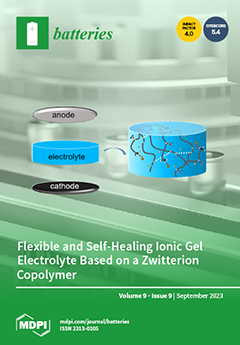In all-solid-state battery (ASSB) research, the importance of sulfide electrolytes is steadily increasing. However, several challenges arise concerning the future mass production of this class of electrolytes. Among others, the high reactivity with atmospheric moisture forming toxic and corrosive hydrogen sulfide (H
2
[...] Read more.
In all-solid-state battery (ASSB) research, the importance of sulfide electrolytes is steadily increasing. However, several challenges arise concerning the future mass production of this class of electrolytes. Among others, the high reactivity with atmospheric moisture forming toxic and corrosive hydrogen sulfide (H
2S) is a major issue. On a production scale, excessive exposure to H
2S leads to serious damage of production workers’ health, so additional occupational health and safety measures are required. This paper investigates the environmental conditions for the commercial fabrication of slurry-based sulfide solid electrolyte layers made of Li
3PS
4 (LPS) and Li
10GeP
2S
12 (LGPS) for ASSBs. First, the identification of sequential production steps and processing stages in electrolyte layer production is carried out. An experimental setup is used to determine the H
2S release of intermediates under different atmospheric conditions in the production chain, representative for the production steps. The H
2S release rates obtained on a laboratory scale are then scaled up to mass production dimensions and compared to occupational health and safety limits for protection against H
2S. It is shown that, under the assumptions made for the production of a slurry-based electrolyte layer with LPS or LGPS, a dry room with a dew point of
and an air exchange rate of
is sufficient to protect production workers from health hazards caused by H
2S. However, the synthesis of electrolytes requires an inert gas atmosphere, as the H
2S release rates are much higher compared to layer production.
Full article





